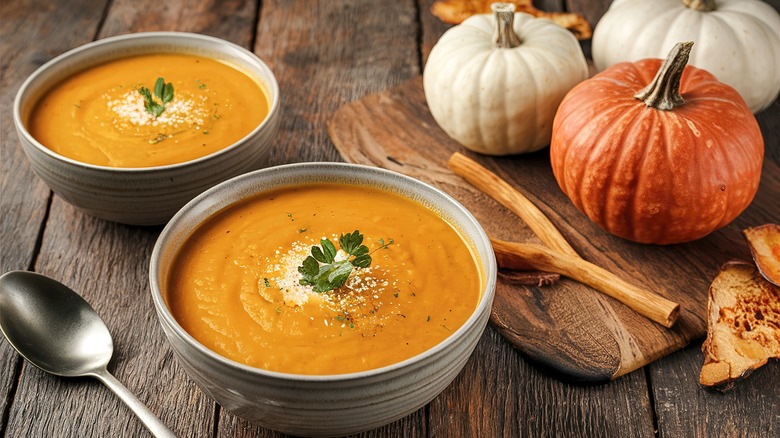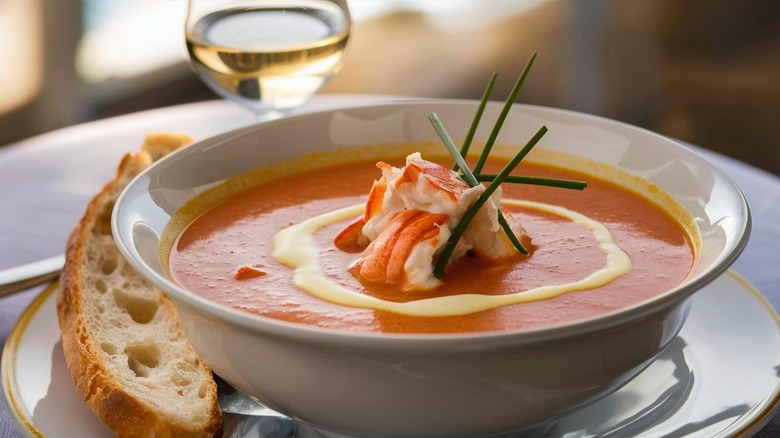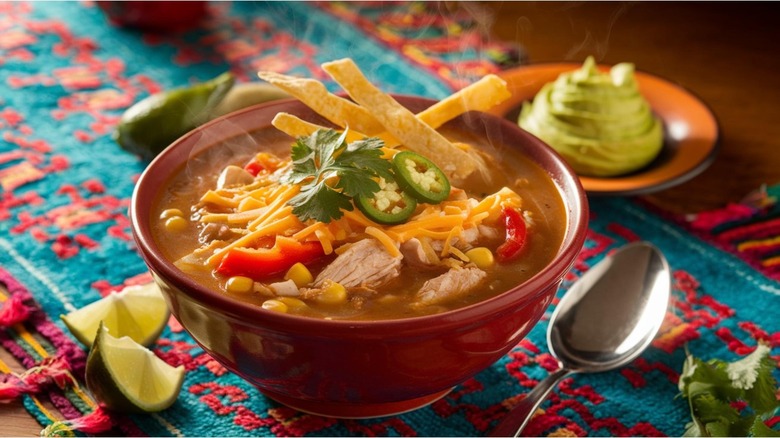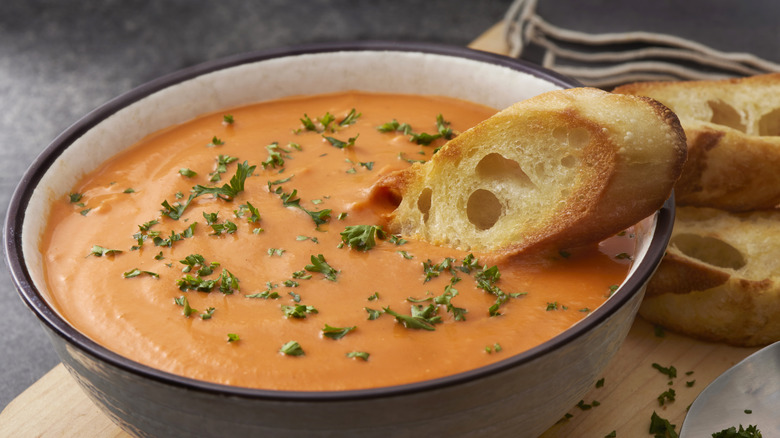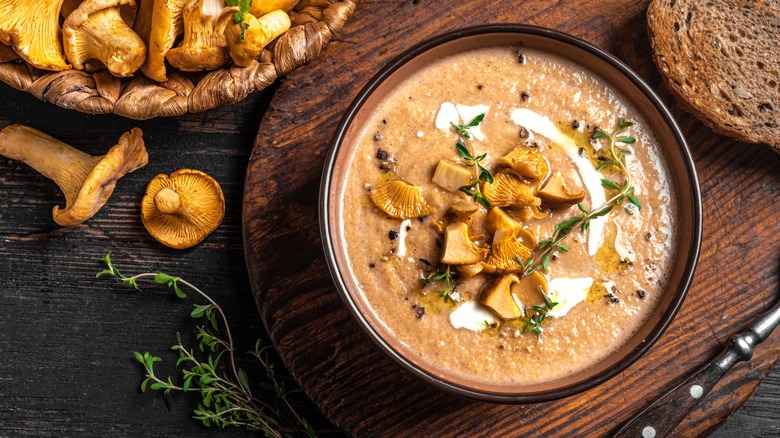The Luxurious Difference Between Bisque And Soup
A soup is apt for any context. Head to a rural environment and communities worldwide often craft a thick, stewed dish. Melding together varying components, it's a food that offers warmth and satiation. Alternatively, head to a fine-dining environment, and it can be hard to pin what's behind luxurious restaurant soups. The dish can also be a vessel for creativity and decadence, a showcase of haute cuisine.
Among creations with an especially elegant texture, few dazzle more than bisque. Employing ingredients like lobster, mirepoix, and nice wine, it's a dish a world away from good old hearty chicken noodle soup. Nevertheless, bisque falls into the soup category, and its delectable distinctions showcase the intricacies of the dish. The creamy, decadent texture, crafted through an elaborate method with a traditional mixture of thickeners, defines the food. It's a soup style that intrigues with its elegant smoothness and rich flavor, making it worthwhile to investigate.
What is bisque?
Tasty bisque is a French dish with roots in the 17th century. Hailing from the coast, it's traditionally crafted with crustaceans like crayfish, crab, lobster, and shrimp. In order to achieve the distinct texture of the dish, chefs would grind the crustacean's shells into a paste, thereby lending a strong seafood flavor and thickening the dish.
While modern renditions stray from such a technique, you can use a roux or rice to thicken the bisque instead. Alongside, a mirepoix of carrots, onions, and celery adds flavor, boosted with a pour of booze like white wine, sherry, or brandy. The cream is often added towards the cooking conclusion — a common way to achieve the food's iconic velvety mouthfeel. To finish, the soup is strained, achieving a thick, yet smooth result. Bisques are typically garnished with the crustacean flesh, as well as herbs.
Seafood is undeniably the quintessential version of the soup, but the term "bisque" has expanded to include blended soups with variable compositions. Whether it's tomato or chicken bisque, the goal is a luxurious, smooth soup with a refined flavor.
What is soup?
Soup, however, takes on a broad definition: Any arrangement of vegetables, meats, or seasonings cooked in a liquid qualify. It's a cooking method that traces back through most of culinary history, with remains pointing to as far as 20,000 B.C. Some of our oldest ancestors discovered the benefit of simmering bones and meat scraps in liquid, establishing soup as one of the first comfort foods. From then on out, renditions have appeared in nearly every cuisine.
From the cold and refreshing chlodnik of Poland to a delectably spicy batch of chicken tortilla soup, no flavors are excluded from the soup format. And the variations span many consistencies, too. Soups like pho come together with delicate chicken or beef broths married with spices, while a hearty soup like minestrone combines a chunky assembly of root vegetables, pasta, meats, and more. Oftentimes, soups showcase a breadth of local ingredients, a nifty way of using what's available on hand. Yet simultaneously, the food style meticulously layers flavors into a harmonious whole, simmering flavors into one.
Bisques come together with an unique assembly process
While seafood and bisque still go hand in hand, the soup is no longer defined by its ingredients and flavor. Instead, it's the delicious creamy consistency that's a hallmark of the bisque style. Take the difference between chowder and bisque — the two dishes reach for a similar array of components, but combine them in distinct ways.
To achieve such a composition, traditional shellfish-based bisque follows a particular assembly process. The seafood is boiled or steamed shell-on, and once cooked through, the flesh is removed. The shells then get sauteed in an aromatic mirepoix that is next deglazed with a high-quality wine or sherry. This two-step seafood preparation is foundational to the soup; the word "bisque" even translates to "twice-cooked" in French.
After, the mixture is turned more soup-like with a broth and thickened with rice or roux. The mixture is simmered, and the bisque is pureed and lightened with cream. The result is aromatic, luxurious, and complex. You can replace the crustaceans with intriguing combinations like a panang curry tomato bisque and nevertheless build intricate flavors.
Soups come in a wider range of textures
Generally, soups can be delineated into two main textural styles. Some employ a clear broth that's been purposefully skimmed and strained to attain a liquid state. Ingredients are then added into such a foundation, creating lots of textural contrasts. Meanwhile, the other type thickens a liquid base, using a variable assortment of components like grains, eggs, flour, puree, and dairy.
Bisque lies in this latter category; the soup style leans into an especially thick and creamy consistency. Even in contrast to other dairy-based soups like cream of mushroom, bisques employ a larger quantity of cream and integrate the dairy earlier into the cooking process. As a result, bisque's special fat-based thickness distinguishes them from other soup types.
Nevertheless, there are soups that attain dense and smooth consistencies through other means. In Chinese cuisine, eggs are employed as a textural thickener, tying together aptly named egg drop soup. You'll also find hearty egg and flour-based creations in the country of Georgia, where it's called "chikhirtma." And bread-blended soups are another regional favorite; Spain's gazpacho relative salmorejo delights with its special thick texture. So, it's always handy to remember that the soup portfolio is expansive, but bisque does delight with its special magic.
